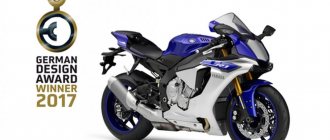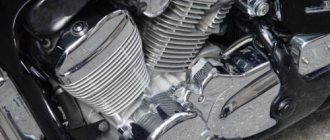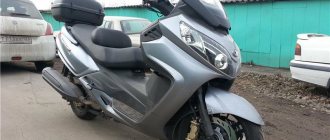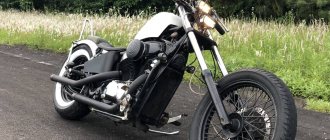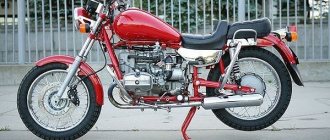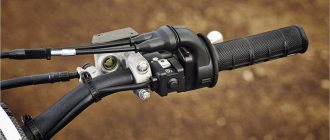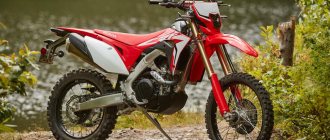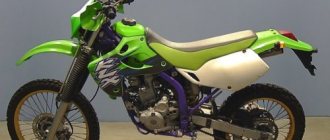The full-size chassis immediately hints that this is serious equipment, and not just another “study desk” for beginners. In addition, even the universally beloved 400 cc Zizer can only sigh sadly and envy the capabilities that the creators have invested in the KTM RC 390. The design also does not disappoint, and it immediately speaks of the country of origin of this motorcycle. Predatory silhouette, angular shapes... clearly, this is a guest from Austria! This bike will never get lost in city traffic, and to everyone who says that 400 cc is not enough, it will only snort contemptuously with the exhaust, after which it will rush off towards the horizon and turn into a dot in a few seconds.
Technical characteristics of KTM RC 390
This motorcycle has a lot in common with the Duke 390, including the engine - a long-proven 1-cylinder liquid-cooled engine that feels great at medium speeds. It doesn't have much bottom end, but it's been retuned to provide more top-end power. 44 hp quite enough for dynamic driving, but you will have to change gears often, since the KTM RC 390 is very demanding in choosing the right gear, and the gear ratios in the 6-speed gearbox are quite short. The motorcycle is also equipped with a slipper clutch, which makes it possible to shift down several gears at once when overtaking without the risk of damaging the mechanism.
The Austrians tried to lighten the KTM RC 390 as much as possible, and they managed to keep the dry weight at 147 kg . To do this, it was necessary, among other things, to slightly reduce the fuel tank , the volume of which is now 10 liters . There is a 320 mm brake disc with a 4-piston caliper at the front, and a 230 mm brake disc with a 1-piston caliper , the same one that is installed on many other KTM bikes, for example, the Duke 230. The suspensions are distinguished by precise operation and sporty rigidity, which and it’s not surprising, because the KTM RS 390 is not “sport-oriented”, it’s a real sportbike, developed taking into account the company’s vast experience in motorcycle racing.
Production
Only first-class and high-tech materials were used in its creation. A review of the KTM RC390 bike by experts proves the company's claim that this is a perfectly balanced motorcycle in terms of power-to-weight ratio. Amazing maneuverability and extreme tilt angles will not leave any athlete indifferent. The bike is ready to turn a boring ride into a real race at any time.
The predecessor, in the image of which the KTM RC390 bike was created, was the no less legendary Duke 390 model. The designers left the engine without making significant changes, but the remaining components were completely replaced with new ones. The chassis has been improved, a large fairing has been installed, and the pilot's seating position has also changed.
Pros and cons of the KTM RC 390
Advantages
- Thoughtful and comfortable fit . Especially for a sport bike - there are no increased loads on the lower back and arms on the KTM RS 390.
- The presence of a host of auxiliary systems , such as ABS and an assistant to facilitate clutch release.
- Excellent brakes that are good without tuning or modifications.
- Low weight , which, coupled with very competent weight distribution, contributes to excellent handling.
- Good wind protection at any speed up to maximum.
Flaws
- High price . A motorcycle from a dealer costs ~400 thousand rubles, and for that kind of money you can buy a slightly used liter sportbike in very good condition. Another thing is that not everyone needs a “liter”.
- Difficult maintenance . KTM RS 390 owners can tell a lot of interesting stories about replacing spark plugs, filters and various fluids.
- Mediocre directional stability at high speed.
- Parasitic vibrations at high speeds.
Price
Since the model has been produced since 2013, in the CIS countries it is sold through a huge network of official KTM representatives. The price of a new unit in the showroom is on average 299 thousand rubles. You can find very decent options on the secondary market. In this case, the minimum cost will be 250 thousand. The maximum price for a device older than two years is equal to the cost of a new one displayed in the showroom. Sales are possible already with some modifications to the fuel system or a replaced fairing.
Reviews from KTM RC 390 owners
Surprisingly evil spendthrift, old Japanese four-hundreds like the CBR400 or XJR400 take off, although the KTM has less horses and torque. The fit with a height of 184 cm is ideal, long arms and legs are not a hindrance. There is enough wind protection, there is no desire to install a higher glass. It rips wildly from a standstill, especially if you rev the engine before the start; after 120-130 km/h it slowly gives up, but up to 150 it drives confidently, overtaking is easy. Personally, the power is enough for my eyes and ears, I don’t see any point in taking anything else, there’s nowhere to drive 200+ anyway, and now they’ve hung cameras everywhere that hit the tail. Vladimir, St. Petersburg, KTM RC 390 '2015.
The motorcycle is obviously not bad, but the price is too high, for this money you can get an R1 or a liter CBR alive and fresh, I’m generally silent about six hundred. Among the scabies, the KTM RC 390 is the best, but the 600cc is a different class, so the KTM didn’t stay long with me, I bought it, rode it and sold it a month later for the same money. Dmitry, Moscow, KTM RC 390 '2016.
I fell in love with this style at first sight, although initially I wanted to take a road bike, I was looking at the Duke with the same engine. Then I came across a review of the RC 390, was hooked, and a week later I bought it. The motor is under warranty, I bought it new, at a discount, since I bought it at the beginning of the 2018 season, and the motor was released in 2022, I haven’t climbed anywhere myself, even an oil change - everything to the dealer. The impression is good, I've driven a little over 5,000 kilometers this season, I drive carefully, and I'm gradually getting used to it. Vladislav, Chelyabinsk, KTM RC 390 '2017.
Improvement options
A review of the KTM RC390 bike shows that the device has very great potential in terms of improvement and improvement of many parameters. Many owners very rarely limit themselves to banal modifications to the appearance. As a rule, the following work is carried out:
- The rear fender is replaced depending on the final purpose of the motorcycle. This can be done for relatively little money.
- Replacing the stock muffler. A titanium structure is installed in place of the factory system. This allows you to increase the service life of the exhaust system, as well as give the motorcycle a unique sound that emphasizes its sporty character.
- Sometimes a new trunk is installed, which will allow you to transport small loads or equipment.
In special cases, fans of fast driving adjust the fuel supply system. As a result, this allows you to increase the maximum speed by an average of 15 km/h. It is worth noting that this cannot be abused, since the motorcycle suspension is quite rigid and an increase in maximum speed can have a detrimental effect on the controllability and stability of the unit.
A review of the KTM RC390 bike shows that this KTM creation perfectly combines power and elegance at a fairly low price. Such parameters cannot but please fans of motorsports and everything connected with it.
At the time of creation, there was not a single analogue that could compete with the bike. Thus, the RC390 confirms that it is not for nothing that it was called the flagship in its class. This is a worthy replacement for everyone's favorite Duke 390.
Similar models
- Honda CBR400R . It is a 95% identical copy of the CBR500R for the European market, but with a reduced engine displacement. Produced for the Japanese domestic market, but also found in Russia.
- BMW S310RR . A lightweight Bavarian sportbike, modern and extremely technologically advanced.
- Yamaha YZF-R3 . Outwardly similar to its famous liter brother, from a design point of view it is more simple. But is that bad?
- Kawasaki Ninja 400R . Structurally, it is an ER-6F model with a 400 cc piston engine, so in terms of manufacturability it has nothing in common with the other competitors mentioned above.
Motor
The engine, mounted in a steel matrix, has not undergone any significant changes. This is the same high-tech, reliable and at the same time very powerful power unit that was installed on the Duke 390. The engine is short-stroke, with four valves, liquid cooling, and two camshafts mounted at the top. The volume was only 375 cm3, however, this does not prevent it from producing 44 horsepower with a torque of 35 Nm. To increase reliability, an electronic fuel injection system is used. It allows for precise fuel supply, thereby ensuring instant responsiveness to the position of the accelerator handle, which is very important when driving on the track and when overcoming particularly difficult sections.
Total
The KTM RC 390 has nothing in common with the 400 cc sportbikes of the early 90s, and among modern light motorcycles in this class it has practically no competitors . This fact alone sets it apart from others. Yes, the KTM company has never followed the path paved by other motorcycle manufacturers, and has not begun to do so now. And we can say with confidence that of all the sportbikes in the “up to 600 cc” category, the KTM RS 390 is, if not the best, then one of the best .
The flagship of motorsport
The new KTM RC390, whose technical characteristics differ slightly from its predecessor Duke 390, sets completely new standards and rules among road motorcycles. It has characteristic sporting features from KTM. Previously, no such carefully thought-out option had been created, both from a technical and aesthetic point of view.
Video Review
Specifications
| Maximum engine power: | 44 HP |
| Working volume: | 373.2 cm3 |
| Motor type (cylinder arrangement, number of strokes): | 1-cylinder 4-stroke Otto engine, water cooled, DOHC |
| Number of cylinders: | 1 |
| Number of valves: | |
| Intake type (Injector / Carburetor): | |
| Bore and stroke: | |
| Starting system (Electric starter, kick starter): | |
| Cooling system: | Liquid cooling, constant circulation of coolant through a pump |
| Transmission (gearbox): | 6-speed gearbox with dog clutches |
| Clutch (Dry / Wet): | |
| Drive unit: | Chain |
| Frame: | Powder coated steel tube trellis frame |
| Chassis | |
| Suspension (front/rear travel): | |
| Brakes (Front/Rear): | |
| Wheels / Tires / Rubber: | |
| Dimensions and weight | |
| Dimensions (Length / Width): | |
| Seat height: | |
| Ground clearance: | |
| Curb weight: | |
| Wheelbase: | 1340 mm |
| Weight: | 147 kg |
| Fuel tank capacity: | 10 l. |
| Battery capacity: | |
| Year of release: | |
| Country of Origin: |
New chassis
Looking at the review of the KTM RC390 bike, you will notice that its chassis is very similar to the time-tested “birdcage” that was installed on its predecessor. Despite the external similarity, it has a completely different geometry in order to improve the sporting performance and ergonomics of the motorcycle itself. Handling was improved by changing the angle of the front fork, as well as reducing the wheelbase. Stability when driving at any speed is what the developers have been striving for for so long.
TEST DRIVE: KTM RC390 (2015) – Orange challenge
KTM has called the RC 390 the most important motorcycle in its lineup since 2011, when the factory announced its 5-year expansion program into the road bike market. I went to Italy to find out why.
MOTOGONKI.RU, September 26, 2014 —
“Four hundred” on the border of the 90s and 2000s became a window to the world for Russian motorcyclists. Thousands of beginners chose the “gray import” as their first bike, and the Japanese second-hand market remained basic for 10-12 years, until local factory representatives returned budget motorcycles to the lineup. The first bestseller is YBR125. The first, but still in demand, why? Most owners will say - this is my first or my first new motorcycle! In 2008, the Kawasaki Ninja 250R entered the game - a small bike with a 'big' style. YBR is a “donkey” for every day, and Ninja became a full-fledged “jap” for a whole generation of motorcyclists, and today, with a 300 cc engine, continues to set the sales pace; Honda's belated entry only slightly stirred things up. But whoever needs a little more will still take the 15-year-old Zizer - it’s cooler anyway. The most budget “four hundred” produces 53 hp at a time. and 150 km/h cruising speed, which is still relevant today. What the consumer of this class has always lacked, and what has always sharply reduced secondary demand, is the lack of a stable market for service and spare parts...
The Most Important Bike
KTM believes that the appearance of the RC series of motorcycles on the market will be a turning point for the company and will allow it to gain a strong foothold in the class of medium-sized plastics, which has never been seen in Mattighofen’s product range before. A full-fledged sportbike with a large single-barrel gun is a dream come true for teenagers who are firmly hooked on another product, the Duke series.
For the developers from Mattighofen, creating the RC 390 is a challenge. The task was formulated and set personally by President Stefan Pierer: the motorcycle must be better in all respects than the worldwide bestseller (Duke), unconditionally comply with the “Ready to race” philosophy and be radically different in style from everything that is sold in motorcycle dealerships.
KTM RC 390 (2015) - style from KIska Design: you definitely won’t be confused with the Japanese!
Click on the image to go to the photo gallery
After a long conversation with RC-series product manager Diego Arioli, his words were imprinted in my memory: “The approach to creating motorcycles has changed a lot over the past few years. To compete well with brands that have been in this market sector for many decades, you need incredible business discipline, even more dedication and staying ahead of the curve. I think the fact that the RC 390 was born is proof of KTM's confidence in where we are going. In fact, we have a real fireworks of plans!”
Diego is confident that KTM’s main rivals in the market - Japanese factories - are following the usual path of reducing costs by completely simplifying technology. But KTM will never do that: “We go differently, along the path of product development, strong and vibrant. The company is product-oriented, this moves it forward. I think KTM has been able to make a breakthrough in sales since 2011, thanks to products, not marketing – Duke, Adventure, now RC are masterpieces!” he added. It is difficult to expect a different assessment of the company's activities and its products from a manager responsible for an entire area. But is there much pathos in Arioli’s words?
KTM's ever-growing range of road bikes: from the 125 Duke in 2011 to the 1290 Super Duke R and RC 390 in 2014 Click on image to go to photo gallery
Over the past year, KTM Sportmotorcycles AG has invested heavily in infrastructure development in Mattighofen, production and R&D, as well as in Indian assets. There will be a separate conversation about Bajaj, first about Austria. The head office is growing before our eyes: in 12 months, 200 new jobs have been created, the group’s enterprises now employ 2,060 people (in 2011 there were 980); 220 people worked in R&D then, and today there are about 400. In 3 years, KTM has mastered the entire road sector of the market, starting with the Duke 125, and then releasing 9 more new models, 3-4 in each season, according to a plan that has not yet been completed (after all, he is 5 years old). And what models are these - KTM 690 Duke, 390 Duke, 1190 Adventure and 1290 Super Duke R. Now, the RC series. KTM's street program consists of 14 bikes and takes up half of the company's lineup. No, there is little pathos here. How many completely new motorcycle models have competitors introduced over the past three years?
KTM manages to make motorcycles cheaper, while maintaining the level of quality in the same way as BMW did at one time, that is, by outsourcing the production of budget series to a reliable partner. BMW found such a partner in Taiwan, and KTM found such a partner in India. The topic of cooperation with Bajaj is a matter of pride because KTM Sportmotorcycles AG is 48% Indian investment. Firstly, Bajaj is delivering strong sales growth in India, a market that aims to become number one in the world, beating China's growth and pushing past the biggest, America's, by 2016. Secondly, "it's no secret that in Austria or elsewhere - “Even in Europe, even in America, it is simply impossible to create high-quality and inexpensive production of the same level as Bajaj,” added Diego.
Diego and Tomas both race and know what they're talking about
Thomas Kuttruff, manager of the KTM PR department, joined the conversation. A simple manager, but not a simple one! Thomas is an avid amateur racer, takes part in two racing series on his Super Duke R. He is as good as the factory testers, which he proved at the Autodromo di Modena, where we moved after the street test of the RC 390. The dashing guy celebrated his 40th birthday on the day of our tests -year anniversary... swimming in an ice-cold pool.
“I think the main thing that keeps KTM moving forward is the courage to make decisions,” Thomas said, not hiding his pride. – The approach is simple: we want to know for sure that we are at the top of all the movement, both in sports and in production. Well, I think all office guys need to ride our bikes. I'll still work on this, don't sit back! We must know what we create and sell, and not from booklets, of course.”
Test drive KTM RC 390 and RC 200 (2015) in Modena Click on the image to go to the photo gallery
From a half-hour “political information” on KTM’s global strategy, which, however, has not changed much since 2011 (except for numbers), I wrote down one phrase in my notebook: “the presence of the KTM logo is a guarantee that you will receive the same level of emotions from any of the company’s products.” But isn't this PR around the power of the brand, Diego? Or...is it the strength of the product? The guys worked for three years until they reached the highest point. No, this is not the 1290 Super Duke R. We are talking about the RC 390: the riding experience on it should be equivalent to the Super Duke, everyone who buys an RC should feel in the saddle of a Super Duke or RC8R, at least. And that's why.
With the launch of Duke 125, 200 and 390 cc. KTM has reached a point from which there is no escape and this product has no right to fail.
The budget motorcycle segment is the “lifeblood” of all motorcycle enterprises in the world. Premium class is prestige, an indicator of the company’s level, but state employees are their daily earnings. All existing players in the market have been challenged and looking at the sales figures, competitors are in a difficult position. Only 390 Dukes sold more than 30,000 in a year, and the “hot cakes” of 200 are selling like crazy in Asia and India, where Honda and Yamaha have traditionally been strong - now they are moving under the pressure of the locals and changing their strategy. The 390th model formed the basis of a radically new product, a full-fledged Supersport motorcycle with all the necessary attributes - this model is aimed not at one region, but at the whole world, from Asia to America, and Russia, including.
Supersport from birth
RC stands for Race Competition, which initially places a special responsibility on the series.
But the KTM RC 390 was firmly on its feet long before journalists and dealers saw it in Modena. He made his debut six months earlier, as part of the ADAC Junior Cup powered by KTM program, which brings together 30 youngsters who have decided to take the step towards a career in MotoGP. KTM, as official supplier and technical partner of the Red Bull MotoGP Rookies Cup and two-time world champion in the Moto3 class, has launched another series for beginners. The prototype concept for Moto3, Rookies Cup and ADAC is the same: a 1-cylinder powerful engine in a rigid chassis to provide a link between series and products.
The difference between the racing version of the ADAC Junior Cup and the street KTM RC 390: the racing version... is 6 hp weaker, and only a couple of kilograms lighter Click on the image to
go to the photo gallery
At the same time, the KTM RC250R prototype for Moto3 and RC 390 do not intersect - this is how the plant maintains the status quo: different developers worked on each bike (the RC250R appeared two years earlier), the motorcycles have fundamentally different chassis, engines - everything except one thing - geometry. If you display the 3D layouts on the monitor, you can see that the main triangle, the edges of which are the fork and the frame beams, are one to one. No one is wondering whether this is a coincidence or a conversion. But the Duke’s chassis does not fit the Moto3; it is somewhat different from that of the RC.
Engine KTM RC 390 (2015) Click on the image to go to the photo gallery
The KTM RC 390 is built around a 4-valve 375cc single-cylinder unit producing 44 PS. and a torque of 35 Nm, weighing only 36 kg, which makes this engine the lightest and most energy-efficient in its class. And the motorcycle weighs only 147 kg. For comparison, the 2-cylinder Honda CBR500R with 47 hp. dry – 175 kg! The 500R is one of the targets for KTM. Not only the 250 and 300 cc Japanese plastics are on the list of “who needs to be beaten”, but also this one, which Honda called the flagship in the “up to 600 cc” segment, including in world sports. In terms of weight-to-power ratio, the RC 390 is superior to the CBR.
KTM RC 390 (2015) - top view - very compact, even at first glance! Click on the image to go to the photo gallery
The first feeling from the position in the saddle is that you are on a 250 cc 2-stroke, which weighs nothing, and at the “waist”, like an iPhone box: the plastic dimensions are only 47 cm; the widest place is the mirrors with built-in turn signals - 81 cm, without them, at the tips of the steering wheel 73 cm.
Test drive the KTM RC 390 (2015) at the Autodromo di Modena: the perfect place for such a motorcycle! Click on the image to go to the photo gallery
There is enough space in the saddle and behind the cockpit (you can slightly change the position if your buns are numb during the trip), but it seems that the motorcycle is designed for a pilot with a height of 165-170 cm and a weight of up to 80 kg. This was indirectly confirmed when we found ourselves on the race track: hiding behind the cockpit during acceleration on the 480-meter straight turned out to be much easier for the Asian pilots (both are 155-160 cm tall as Dani Pedrosa). This compact body gave them a head start of about 10 km/h at the 150-meter braking point before entering the first turn.
Lead designer of the KTM RC 390 Sebastian Sekira
On the only straight section of the motorway during a street test, we managed to briefly open the handle and squeeze out 160 km/h... But from talking with the lead developer of the RC 390, Sebastian Sekira, who himself is a fan of accelerating on his “home” track, it became clear that the bike can do more: “175 km/h,” the Austrian answered without blinking.
The motorcycle, which had been thoroughly tested by races across Europe even before trying on the “civilian dress”, turned out to be the ideal tool for a track day on a track such as the Ferrari test site - Autodromo di Modena, compactly integrated into the landscape, replete with technical S-shaped ligaments, but not plugged, but smooth and flowing. At the presentation, one “legend” associated with Ferrari was mentioned - why they decided to launch the KTM RC 390 right here, 5 minutes drive from the factory - a kind of “hello to Maranello”: when creating 200- and 390-cc engines, KTM used technology with two overhead camshafts and valve train drive through finger-followers, like supercars and Formula 1 cars. In the motorcycle industry, this technology was first used in the engine for the KTM 1190 RC8R superbike. So high rpm (10000+) is not a problem for the RC 390.
Looking at the diagram of the Modena ring, I sadly remembered our Myachkovo - what it could have been... Click on the image to
go to the photo gallery
But it seems to me that the choice for this place fell for a different reason. Autodromo di Modena is the dream of a small motorcycle owner: a relatively short lap, no long straights and the ability to rev the engine completely in long arcs - it’s impossible to think of a better place to test the KTM RC 390! For those used to cranking up their 250cc and 300cc twin-barrels, the 375cc KTM will feel explosive at the same rpm. Peak power at 9500 rpm, maximum torque at 7500. Keep the gas open all the time at 6000-7000 rpm even in narrow turns, only dropping and increasing gears, almost without using the clutch, adding more at the exit of turns - to track, the flow of driving pleasure does not stop for a second!
Test drive KTM RC 390 (2015): after several sessions, the Metzeler Sportec M5 profile is almost completely rolled out Click on the image to go to the photo gallery
The stock KTM RC 390 is equipped with Metzeler Racetec M5 tires, which are very soft and grippy, they allowed the motorcycle to be tilted all the way to the pegs and the rubber profile to be rolled out almost to the edge. Here, for the first time in a week, I regretted that the KTM Pure Adventure membrane textile was not equipped with sliders. But the sliders on the Alpinestars boots were pretty worn out, clinging to the asphalt before the motorcycle footpegs reached it.
Once upon a time there were two twin brothers...
One went to a sports school, and the other started smoking... An old topic, but it has nothing to do with KTM: 390 Duke and RC 390 - both have been going to the gym since childhood. It’s just that one of them, already in middle school, showed a craving for the opposite sex, and the other - for a great career in professional sports.
It is not entirely true or even completely wrong to say that the RC 390 is simply a dressed-up Duke. Yes, their engines are no different, even in gear ratios. The only difference is that the RC 390 has a larger generator to power the dual headlights. But when it comes to chassis, ergonomics and handling, the Duke and RC 390 are nothing alike.
KTM RC 390 (2015) chassis: the frame is different from the Duke - it is shorter, the fork angle is sharper, the wheelbase is shorter, completely different suspension Click on the image to go to the photo gallery
After many changes made to the frame, the ground clearance changed, the wheelbase became 1340 mm (adjustable +/-15mm), the fork was lowered another 1.5 degrees, and the offset was reduced. The RC 390 chassis is less responsive, and the WP Ø43mm fork and rear shock absorber, which has an original mount, are both different from the stock ones on the Duke. The clip-ons sit lower, so you can lie down on the tank (if your height allows). Sitting forward and leaning into the handlebars changes the ride feel (again, compared to the Duke's almost straight-line ride). The position of the pilot determines a different weight distribution: the Duke has a ratio of 46% front wheel to 54% rear, while the RC 390 has 49 to 51, which also plays a big role in handling.
Comparison of fit on the KTM RC 390 and 390 Duke: the difference is not only in ergonomics, but also in weight distribution - the RC has more weight on the front wheel Click on the image to go to the photo gallery
All for the sake of a more dynamic ride, acceleration and steep braking. The small difference in the chassis - just 28 mm - makes a big difference between the two motorcycles! Overall, the RC's chassis is much sharper and more confident than the Duke's, although it still felt "very sporty" to me. And on a straight line, the RC 390 is faster than the 390 Duke by about 15 km/h (due to better aerodynamics). But the comfort in the saddle is undoubtedly higher in the Duke: the seat of a street motorcycle is thicker and softer, and the pilot’s “buns” last longer than a hundred kilometers of continuous riding. The RC saddle, on the other hand, is comfortable for constantly changing positions.
We tested the KTM RC 390 in all weather conditions Click on the image to go to the photo gallery
We tested the KTM RC 390 in different weather conditions. I should note that climbing the high hills of Modena in search of fast switchbacks in the rain is not a good idea, mainly due to the disgusting condition of Italian country roads and half-asleep drivers. But after all, I realized that we were deliberately sent to this “green hell”, where the removed top layer of asphalt is more the norm than a temporary inconvenience: in these conditions I gained faith in the power of the 4-piston caliper with a 300-meter disc from Bybre and Sportec tires, and at the same time 2-channel ABS Bosch, which the RC 390 is equipped with by default.
The turn felt as slippery as ice until we believed in the magical power of the Bybre brakes and Metzeler Sportec M5 tires... Click on the image to go to the photo gallery
Before the planned photo shoot, looking at the careful attempts of the journalists to brake and tilt the motorcycle in a turn that was completely (at first glance) unsuitable for this, the instructor leading the group said: “Guys, at least try to lock the front!” And he spoke the truth: it was worth trying and seeing that no matter how hard you brake, the front wheel did not lose contact with the completely damp asphalt. Only once did the anti-lock braking system intervene, returning the slightly raised rear wheel to the ground (it was on a good run down a hill). True, by the time we realized that the grip was excellent , the photo shoot had already ended, so the journalists, excited by the new experience, during a short smoke break (especially the Turks) began to misbehave - burning rubber, performing rolling-wheelies, and so on. On wet asphalt all this was especially easy.
KTM RC 390 (2015) is equipped with a single 300mm brake disc and 4-piston radial caliper Bybre (By Brembo) Click on the image to go to the photo gallery
We were able to fully test ABS upon returning to Modena, when a bus pulled out from an adjacent street in front of a briskly galloping group “in orange swimsuits.” During press tests, the instructors leading the group rarely worry about maintaining the speed limit and where it would be worth going “50”, they usually fly “80”. I had to brake from 70 km/h to almost “0” in 20 meters - all the pedals and various magic words were already involved. But during the Bybre tests, not a single bus (or its driver) was harmed. Bybre is a division of Brembo (after all, Bybre stands for “By Bre[mbo]”), which produces brakes using Italian technology for installation on small-capacity motorcycles. Yes, their front calipers are not milled from a single piece of aluminum and are not decorated with the famous red logo, but they saved our health, three modest testers from Russia, Turkey and Malaysia.
Engine braking is a feature of the RC 390, for which you can simply fall in love with it: clear and easily predictable, no comparison with the same “400” or 250-300 cc Japanese “double-barreled”! The “big pot” comes in and works efficiently, just like on a “big” motorcycle. You apply the front brake and the bike stops at the point where you want it. The short wheelbase, 66.5° fork angle and front-biased weight distribution give an excellent feeling of balance under the hardest braking, both on the track and on the road. There is clear feedback from the chassis, the tank and linings are fixed very close to the load-bearing elements and the area of contact of the knees with them is large - you can feel how the wheels, how the suspension, how the engine behaves. During all four sessions of experiments, I never blocked the wheels by careless handling of downshifts or brakes.
It is not easy to answer the question of how much an engine consumes by draining only one tank. The dashboard from the KTM RC8R is a full-fledged on-board computer that will show instant and average consumption and tell you how much gas is left. You shouldn’t put too much faith in the latter: the average flow rate can fluctuate twice during the day! For example, “my” RC took part in tests a couple of days before us, when the weather was sunny and hot, which means the motorcycle was not spared: when the bike came into my hands, the average consumption was 7 l/100 km. But when we went to the mountains, the figure dropped to 3.4. Returning to the track, in an hour (!) we managed to bring it to 5.3 liters. In the city, the instantaneous consumption indicator dances from 23 to 32 km per 1 liter, and this is a large fork. However, a 10-liter tank was enough for us for 220 km.
Total
Like all bikes with orange frames, this one is controversial, but definitely cool. Plus, unlike others, the RC 390 is very forgiving. Would I recommend it as the first one? Yes. It is lighter than its classmates, stiffer, clearer and clearer, looks better than any entry-level motorcycle and, if necessary, is ready to go to the track “as is”, even without changing tires. I think that after the RC 390, any 300- or even 500-cc Jeep will seem too... dull.
In Modena, during a visit to the Ferrari House and the Ferrari-Maserati Museum, a small crowd gathered around the motorcycles (there were few visitors that day), the guards began to heatedly discuss among themselves the advantages and disadvantages of the RC 390. One of them was absolutely sure that in front of them is a 1000 cc superbike. They didn't disappoint him.
The style was worked on by Kiska Design for several months, and the result was motorcycle art. For example, "tail". You think it's a "plug" for the passenger seat (as the Italians like to do). No, this is the passenger seat itself: molded polyvinyl chloride foam, resistant to abrasion, temperature changes and precipitation, quite soft and elastic when compared with the “perches” on the “japs”. I started with a VFR400R and rarely carried passengers - they were hurt and scared (yes, a sportbike is a test). The VFR will likely beat the RC 390 on the highway due to its slightly higher peak speed. But after a couple of turns, the light and nimble “Austrian” will outperform the almost 200-kilogram “Japanese”. And it is new, with an official guarantee, and you won’t have to look for spare parts at Japanese auctions and dismantling sites. Then decide for yourself.
Pros: + excellent chassis, grippy tires on the base and very cool brakes + elastic engine with great potential + unique style from Kiska Design + included passenger seat, quite comfortable and discreet
Cons: - mirrors as a “design element”, but it was not possible to adjust them - I would like to see clearer operation of the gearbox - it’s easy to catch a false neutral - unclear algorithm for triggering ABS on the rear circuit
Photo: the author, Marco Campelli and Alessio Barbanti. All photos are available in higher resolution, just click on the link and the gallery will open.

